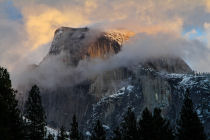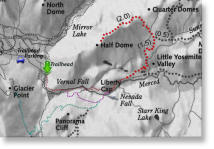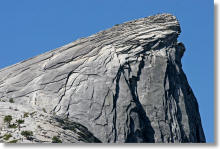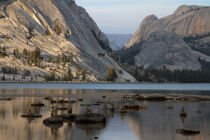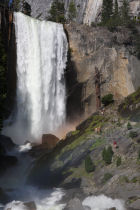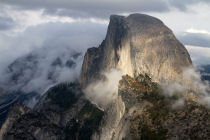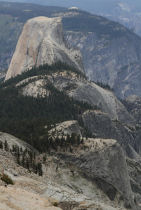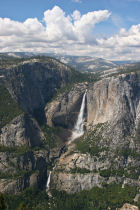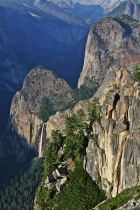
The Hazards of Half Dome: Surviving the Cables
The approach to Half Dome is steep and difficult. The last 400 vertical feet (130 meters) up the eastern slope are so sheer that Yosemite staff have installed cables for you to cling to as you pull yourself up. Without the cables or serious mountaineering gear, the ascent would be impossible. You'll find poles holding the cables up every ten feet or so along the slope, with a 2x4 attached to each set of poles at ground level so you can rest and contemplate your mortality before you attack the next section of cable.
If you slip while you're climbing the cable section and slide outside the cables, you're likely to fall to your death. Use extreme caution here. Here's what you should know so you can haul yourself up the cables and arrive at the top intact:
1. Wear the grippiest shoes you've got.
Sneakers won't cut it - some of the cable section is so steep and slippery that ordinary tennis shoes just can't gain purchase on the granite. You can pull it off with trail running shoes (I have), but you still might experience some iffy moments (I have).
2. Wear gloves.
Not just to keep from getting blistered by the cables, but to help you grip well. Don't wear slick or worn out gloves, because you'll find your grip on the cables slipping at the moment in your life when you have never, ever, more sincerely wanted a secure handhold. And don't wear fingerless gloves, either, unless you want to see what your fingers look like without all that skin covering them.
At the bottom of the cables there's usually a pile of gloves discarded by previous hikers. If you didn't bring any of your own, you can help yourself to a pair, though it's not guaranteed that you'll find a match. The Park Service is not a fan of the big pile o' gloves; they have to clean it out every fall and have reported finding rat's nests in it. Given that there will now be rangers posted at the bottom of Quarter Dome periodically to check permits, they might begin cleaning out the glove pile more frequently.
3. Clip yourself to the cables as you go.
Not many people do it this way, but it's hard to see why not. Seatbelt advocates only wish they could make as dramatic a case for seatbelts as you can make for a mountaineering harness here just by looking down. Check at your local rugged-outdoorsman-oriented sporting goods shop for a via-ferrata gear setup, which includes a harness, a Y-shaped energy-absorbing lanyard, and carabiners.
4. Take everything out of your backpack's outside pockets...
...and zip it inside the pack before you start up the cables. As you go, you'll see a steady stream of empty water and gatorade bottles skittering down the slope. These bottles are popping out of the outside pockets of backpacks worn by people who haven't had the better-than-puppies experience of reading this website.
5. Don't guzzle a thermos of coffee before you take on the cables.
There's no place to go to the bathroom on top of Half Dome. Once you start up the cables, plan on holding it for a couple hours.
6. Be patient and look out for your fellow climbers.
Your lives are in each other's hands. If someone above you falls, they could take you out, too (another reason to clip yourself to the cables as you go). Don't push anyone to go faster than they're comfortable with.
7. Be prepared for delays getting onto the cables and for delays once you're on the cables.
Though the crowds are nothing like the ones from the days before the permit system, don't be suprised if you have to wait to get onto the cables. And once you're on the cables, you'll frequently find that someone has frozen from fear, muscle cramps, or fatigue. Don't plan on a sprint up the cables. Some people try to get around the traffic jams by going up outside the cables, but it's extremely dangerous and can unnerve other hikers nearby - in fact, it can also unnerve people miles away who are just reading this sentence - and it's definitely not recommended.
8. Test the poles holding up the cables before you put your weight on them.
The cable route suffers wear and tear over the course of a season. You may find a 2x4 to be missing (which means twice as long of a hike between chances to rest) or that some of the poles are loose and will pull out of the rock if you're not careful. The cables are anchored into the rock separately from the poles, so the cable integrity won't be affected by loose poles. It's still unnerving to see, though, and putting your weight on a pole that subsequently pulls out of its hole could have a disastrous effect on your balance.
9. If there are thunderclouds around, get back below tree level.
There's a plaque at the base of the cables that tells you not to climb the cables if there are thunderclouds anywhere in sight. There's another plaque at the top of the cables suggesting ways to enhance your expected lifespan if you get caught in a thunderstorm while you're on Half Dome. Take neither of these lightly. People have died from lightning strikes on Half Dome, and if there's any worse place to be during a thunderstorm than on a high, completely exposed surface like Half Dome, it's probably hanging onto iron cables while you climb back down the side of that exposed surface. Even if you manage to avoid getting struck by lightning, the rain from a thunderstorm will make the granite surface of the cable route even more slippery and dangerous than it already is.
Afternoon thunderstorms are common in Yosemite, so it's usually recommended to get an early start (say, 6 or 7 a.m. if you're starting from Yosemite Valley) and be on your way back down the cables by 1 p.m. or so.
10. Don't try to climb the cables if it's been raining.
The granite is slippery to begin with, and rain just makes it that much worse. If you must try it anyway, please call your mother first so she can bet against you surviving and at least make some money to compensate her for all the trouble she took raising you.
11. Hit the weights before you go.
You need to be in good shape to climb Half Dome, and this doesn't just mean calves of steel. Your arms will do much of the work while you're pulling yourself up the cables. If you couldn't arm wrestle Olive Oyl, you're not ready for Half Dome. You'll use your arms on your way down the cables, too, so make sure you've got enough strength left to get down them again - there's no other way off the top.
12. Bring plenty of fuel.
'Cause you'll consume lots of calories on this trek. Figure that you'll feel like drinking 100 oz. or more of liquid on the route. The nearest potable water is at the bridge below Vernal Falls, six miles (9.5 km) back down the trail from the top of Half Dome. Getting cramps from dehydration or being weak from hunger while you're on the cables can have fatal consequences. And although the ill effects aren't as immediately dangerous, don't forget sunscreen or chapstick, either.
13. Don't forget your permit.
Since 2012 it's taken a permit to climb the cable route no matter what day of the week you're doing it. A ranger will be stationed at the base of the subdome and no one without a permit will be allowed past, no matter how charming. The base of the subdome, incidentally, is not the base of the cable route, but about a quarter of a mile before, where a series of switchbacks begins. It's right below where the yellow line begins in this photo.
Here are more details on the permit process.
